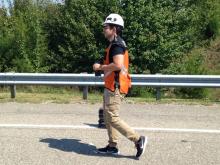
Ensuring worker safety and up-to-date driver information is crucial to ensure that roadworks are not a source of danger and delay. Andrew Williams looks at a scheme on the A14 in Cambridgeshire, UK
In recent years, portable workzone ITS solutions have emerged as important tools in the management of major roadworks and system upgrade projects - and are viewed as an increasingly vital means of ensuring any ongoing traffic flow disruption is kept to a minimum. The technology forms a central component of an ongoing project in Cambridgeshire, where leading mobile variable message sign (
So, what portable workzone ITS technology was deployed as part of the project? How exactly was it used? What are the main operational and financial benefits? And what innovations and trends in the development and deployment of the technology can we expect over the next few years?
Journey time solution
In broad terms, the technology deployed by MVIS and Bartco as part of the scheme enables real-time journey information transmitted from the National Traffic Operations Centre (NTOC) to be displayed on a number of portable VMS positioned along the length of the project. This enables an average of 85,000 drivers each day to navigate the potentially disruptive roadworks more easily and efficiently and helps to keep any potential journey disruption to a minimum.
As Matt Felce, technical manager at MVIS, explains, the project began when the A14 Integrated Delivery Team, acting on behalf of Highways England (HE), contracted the company and asked it to embark on the largest installation of its innovative DATEX JTS (journey time solution) technology to date. As part of the initiative, MVIS also worked alongside display manufacturer Bartco to deploy a total of 36 VMS-A and VMS-C units, capable of displaying accurate journey times from a drivers’ current location to the end of the affected stretch of road - enabling them to quickly gain a comprehensive overview of the predicted journey duration and, if possible, allowing them to select alternative routes.
Display message
The VMS-A units, capable of operating on a combination of battery and solar power, are billed as being suitable for inner city and urban works or for roads with speed zones up to 50mph. Each unit can be used as either a standalone temporary VMS, or in conjunction with radar, to display a simple message, a message and the motorists’ speed or speed, only - as well as ‘too high’ and ‘too fast’ messages. Meanwhile, the VMS-C unit can be used on all roads – particularly those where speeds are greater than 60mph. Users can communicate with both the VMS-A and VMS-C units using GSM, SMS, internet, satellite, web-based, Bluetooth and serial systems. Both types of unit can also be programmed by a laptop on site, as well as via modem, SMS or internet - with an Apple app also available for the VMS-C.
According to Felce, the journey times themselves are calculated using DATEX II ‘actual time’ journey time data, which is collected by in-vehicle sensors before being relayed to the network by NTOC. For MVIS, a key advantage of this approach is that journey time information is renewed every five minutes, with the messages displayed precisely matching those displayed on Highways England’s fixed signs - in the process helping to facilitate improved continuity and easier interpretation by motorists.
Reduced travel time
“We have 22 VMS-Cs being used for journey time information and night-time closures along the main works route. A total of 14 VMS-As also display journey time and safety messages on the approach roads to the works route - and a Solar IP (intelligent platform), that is being used to monitor temporary traffic lights on an approach road,” says Felce.
“The DATEX journey time solution works by calculating route times based on verified data supplied to us by HE for each individual sign. This is done on our own servers, which in turn send the messages to our signs,” he adds. The data itself is generated by HE’s fixed infrastructure of loops and automatic number plate recognition (ANPR) cameras - along with floating vehicle data. This is the same source of data that HE uses itself to display journey times on its fixed VMS, which ensures a consistency in the times given. If there is ever an emergency, or a need to inform the public of road closures, Felce reveals that the same signs can also be sent an overriding message using the company’s proprietary Web Studio technology, which MVIS claims reduces travel time and costs by enabling the “instant communication of traffic information from any Wi-Fi-enabled Apple device including laptops, iPhones and iPads”, allowing users to “view a map of their signs and zoom in, observe and adjust any number of signs in line with any developments on the ground”.
Smart motorways
In addition to the Cambridgeshire scheme, MVIS has also supplied VMSs as part of a customer experience pilot project on the M1 corridor, which incorporated smart motorway roadworks at three sites between junctions 42 and 15, and as part of a £1bn infrastructure regeneration project in Nottingham.
As a result of what Felce describes as the high efficiency of the MVIS equipment, he believes that a key benefit of the system is that there isn’t any need to provide mains power even on a long-term scheme such as the A14. “This means that our signs can be deployed quickly and moved around as the scheme’s needs change,” he says. “And because we use the DATEX information to drive our journey time solution there isn’t any requirement for additional plant to collect the data. This results in less road side clutter and a lower overall cost.”
Future developments
Felce adds: “We also use the latest developments in mobile communication in order to provide an industry-leading level of service. Also, the messages displayed replicate precisely those shown on HE’s fixed signs, promoting better continuity and ease of motorist interpretation than has previously been available, when information featured on temporary VMSs has not been generated by NTOC.”Looking ahead, Felce also reveals that MVIS is currently in negotiations with transport management organisations across the UK regarding potential smart motorway and major scheme projects - and is also working to expand its international network. “I think the main development over the next few years will be the integration of different suppliers’ equipment in order to provide dynamic, automated safety messages for both the public and workzone staff,” he concludes. A driver aware of a workzone is significantly less likely to crash
In addition to providing journey time data, portable workzone ITS solutions can also be used for a wide range of other purposes. One interesting example is the Traffic Information Center (TIC) software-based system deployed by traffic data specialist
In O’Neill’s view, the single biggest benefit of such systems is safety - largely because a “driver who is aware of an approaching work zone is significantly less likely to crash, causing loss of life and property”.
He continues: “TIC also provides coordination between agencies. In one








